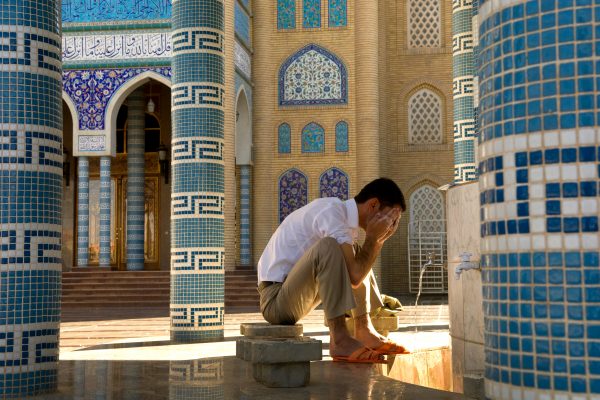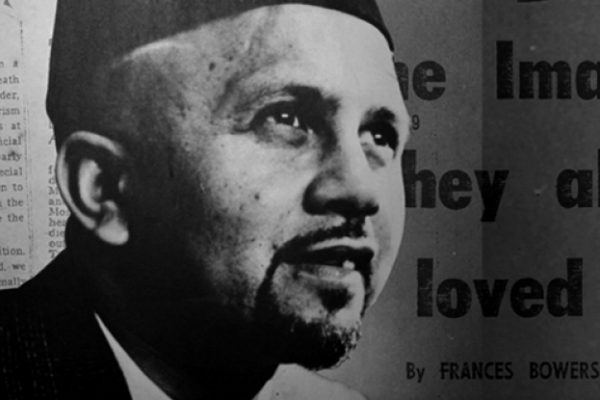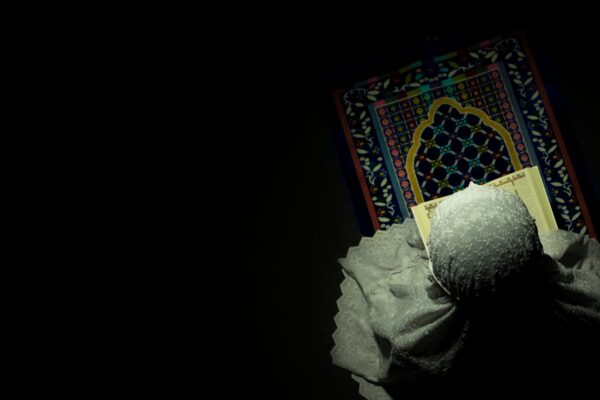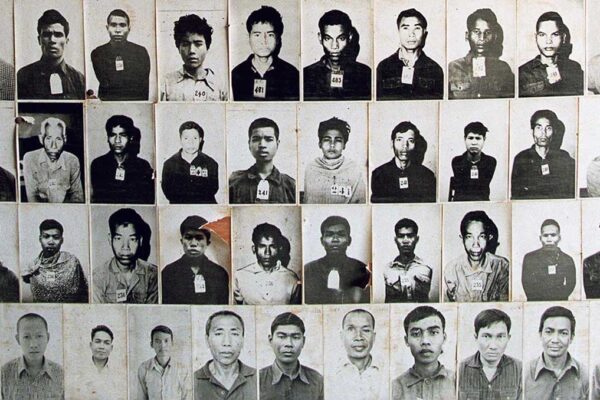The reports that say the Prophet was “white” (bayd/abyad) can have the meaning of unblemished or bright, and not be a reference to skin color at all according to this. Moreover, in other contexts, colors are utilized in a strictly symbolic sense.
The reports that say the Prophet was “white” (bayd/abyad) can have the meaning of unblemished or bright, and not be a reference to skin color at all according to this. Moreover, in other contexts, colors are utilized in a strictly symbolic sense.
A few months ago I posted the following on Facebook: “If you think that an Arab man who lived over a thousand years ago in the middle of the desert had white skin, I invite you to reconsider that.”
I somewhat regret writing that post because the Prophet of Islam is not any Arab man, and even though I did not say that he was, no doubt there was a better way to pose the “challenge.” It is so important for us to shed our preconceived notions and drop some of our racial baggage when talking about anyone who lived in an era so different from our own – especially the person of the Prophet. That was, in large part, the point of that post and point for this article.
However, not all that racial baggage is useless, in fact, some of it may provide a useful lens without which we would be lost in the weeds. That’s because racism, or more particularly colorism, is nothing new in the umma. The society in which the Blessed Prophet was born into had its own kind of color caste that was not only restricted to color but also ethnicity, language, and wealth. Like most caste systems it prejudiced people in many ways, both socially and economically.
But none of this was an issue because it was the norm, it was custom, it was not on the lips of people in the public square, or in the gathering of Mecca’s chiefs. Rather, the Prophet recognized colorism and its evil partner classism as the poisons they were and so, radically, he addressed it and redressed the wrongs it had produced. So this is what I mean by saying that our baggage can also be our lens, because it helps us see – though less perfectly – the kinds of wrongs that the Prophet himself saw.
There is no moral value attached to the color of someone’s skin. The Prophet made this clear. There was, however, something to be said for the quality of someone’s complexion – whether it was bright or dull; there was also something to be said of the character of someone’s face – whether it was pleasant or surly. All of these attributes, bright, dull, pleasant, or surly can be applied to any skin color, from pale white to blue-black and all of them could possibly hint at an aspect of a person’s spirit manifesting on their face.
I won’t seek to answer the question: What was the Prophet’s skin color? For one, I don’t know. Second, this question is only interesting to me out of a sense of love for the Prophet and a need to visualize him and contemplate his countenance in order to feel more connected to him. Not for one second should any one of us think we are out of bounds for talking about this. If it didn’t matter, scholar after scholar would not have devoted book after book to detailing every attribute of the Prophet (physical and nonphysical) that they could acquire. They would not have written about it if it was not important, and sure enough when we describe the Prophet to our children, or our students, or neighbors we often lean on the description of his physical self that we’ve learned about to carry the meaning of the message. For most of us, it is a matter of devotion and love that we care to contemplate the face of the Prophet and make him more real in our lives.
So what was the Prophet’s skin color?
Rather than answering this question, I’d like to lift up the varied reports found in books of hadith that describe the Prophet’s skin color in seemingly contradictory ways. Moreover, I want to talk about the challenges that might arise from describing the Prophet in our modern American context, a context in which his describers were not writing. I also want to highlight that this is not the only complication because the contexts in which these reports were written also suffered from a past that may have been equally troubled by racism and colorism. It’s probably more realistic to say that just as racism still exists in America after the abolishment of our most racist institution – slavery – it likely still existed in these pre-modern contexts as well.
I have often read and heard scholars, teachers, and ordinary believers describe the Prophet’s complexion as white or light-skinned. Today, to refer to the Prophet as white connotes all kinds of images and concepts that the Prophet is unencumbered by and free from. Calling him white does not take into account that whiteness, in an American context at least, takes on a very particular meaning, associated almost exclusively with white people of European ancestry with particular historical markers vis a vis others in American society. People will draw on their experience of whiteness in their own context and as they’ve come to understand it to determine what that may have looked like on the Prophet and how he may have carried himself among others.
Conducting some research I came across a fascinating article on this very topic called “The De-Arabization of Islam and the Transfiguration of Muhammad in Islamic Tradition” by Wesley Muhammad. Although I do not support his definitive conclusion that Prophet Muhammad was a dark-skinned Arab because I do not feel comfortable making such a final designation, Muhammad does provide some evidence for his conclusion. For the purposes of translation, many of the hadith quoted here will be taken from Muhammad’s own translation, which at a cursory glance seem correct, and are in fact found in the collections of hadith that he attributes them to. However, I make no comment as to the strength of the various hadith.
First, we should state the obvious, Prophet Muhammad’s complexion is characterized as “white” or “abyad” in some hadith. The Shamail of Tirmidhi has the following report:
“The Messenger of God had a white complexion, which was slightly reddish, and had a medium-sized body.”
In the Sunan of Tirmidhi he reports a hadith from Anas b. Malik that puts the Prophet’s complexion as a mean:
“The Messenger of Allah (s) was neither tall, such that he would stand out, nor was he short. He was not albino-white (al-abyad al-amhaq), nor was he deep black (adam). His hair was neither very curly nor completely straight. Allah commissioned him towards the end of his fortieth year. He remained in Mecca for ten years and in Medina for ten years. Allah caused him to pass away at the turn of his sixtieth year and there was not found on his head and beard [as much as] twenty white hairs.”
Wesley Muhammad complicates what might be the literal understanding of white-skinned by lifting up an entry by Lisan al-Arab, the well-known Arabic dictionary by Ibn Manzur:
The Arabs don’t say a man is white [or: ‘white man,’ rajul abya∙] due to a white complexion. Rather, whiteness [al-abyad] with them means an external appearance that is free from blemish [al-zahir al-naqi min al-uyub]; when they mean a white complexion they say ‘red’ (ahmar)… when the Arabs say, ‘so-and-so is white (abyad – bayda), they [only] mean a noble character (al-karam fi l-akhlaq), not skin color. It is when they say ‘so-and-so is red’ (ahmar- hamra) that they mean white skin. And the Arabs attribute white skin to the slaves.”
The reports that say he was “white” (bayd/abyad) can have the meaning of unblemished or bright, and not be a reference to skin color at all according to this. Moreover, in other contexts, colors are utilized in a strictly symbolic sense. For instance, most of us will be familiar with the hadith which teaches us that sin shows up as a black spot on our heart that grows the more we continue to sin. This is not taken literally, either today or in the past, because it is understood that blackness is being employed in a strictly symbolic manner.
It is possible that white, red, brown, and black are used on a spectrum that is particular to the range of shades that were commonly found among Arabs at the time. Color may seem like a universal form of demarcation, but colors do not always translate exactly and in tact across cultures. Even among different cultures in the same country confusion can arise. For example, the phrase tall, dark and handsome does not imply that the man is dark-skinned i.e. of a deep brown complexion, rather it means that the man has dark brown hair and possibly (but not necessarily) an olive complexion, which for white Americans would be about as dark as a white person could be. On the other hand, for black Americans to say that a man is dark implies that he is of a deep brown skin tone because that is in the range of possibilities for blacks.
In fact, every subgroup is going to have a different understanding of what it means to be dark-skinned or light-skinned depending on the range of complexions that are found within each group. To further illustrate the point, if the phrase tall, dark, and handsome as it is used among white was to be translated into Arabic, one would have to explicitly translate it as tall, dark-haired, and handsome. Otherwise, the meaning would be lost.
There are multiple reports (hadith) that describe the Prophet’s skin color as brown (asmar) like the following from the Jami of Tirmidhi:
“Anas narrated: ‘The Messenger of Allah was of average height, neither tall nor very short, he had a good build, brown in complexion (asmar al-lawn), his hair was neither curly nor straight, and when he walked he swayed slightly.’”
Although many Muslims are familiar with this kind of characterization of the Prophet which puts his most identifiable physical features in the middle of a range, many do not hear the hadith(s) which describe his skin color as being in the middle of two extremes as well. The following hadith states explicitly that the Prophet’s complexion also followed a means:
Also from Anas b. Malik: “The Messenger of Allah (s) was neither tall, such that he would stand out, nor was he short. He was not albino-white (al-abyad al-amhaq), nor was he deep black (adam). His hair was neither very curly nor completely straight. Allah commissioned him towards the end of his fortieth year. He remained in Mecca for ten years and in Medina for ten years. Allah caused him to pass away at the turn of his sixtieth year and there was not found on his head and beard [as much as] twenty white hairs.”
What accounts for the variance in reports? Well, in some cases it seems that certain descriptors were illustrating the luminosity of his skin, i.e. the quality, while at other times they were describing his color. In the former case, the quality of his blessed skin is always described as luminous, beautiful, and clear, while in the latter case of his color there seems to be a variety of reports.
Why does it matter?
It matters because there is an ethic around skin color, not to mention a long history of colorism nationally and globally that still lives with us. It is important that we check that and not allow it to distort the truth in one way or another. My main goal here was to lift up distinct reports that give us different information about the Prophet’s skin color, if only to make the reader aware that they exist.
I think it is very easy for Muslims to get on the bandwagon to criticize Christians for two thousand years worth of portrayals of Jesus as a white man, but is it more difficult for us to talk about the skin color of the Prophet? Is it possible that some of us cannot imagine the Prophet as any other color but white because of our own baggage and the standards we carry for both beauty and holiness? If all of our literature pointed to the Prophet being brown would we celebrate that or would we ignore it?
My point in this article is to argue that notions of race, ethnicity, or skin color across cultures and centuries cannot and should not be talked about without honoring the particular and idiosyncratic ways in which each culture articulates those notions and lives them out. When religious figures – who our lives are profoundly impacted by – are the center of that discussion, we ought to be even more careful.
This article was first published on Sapelo Square by author Faatimah Knight. You can find the original article here.










